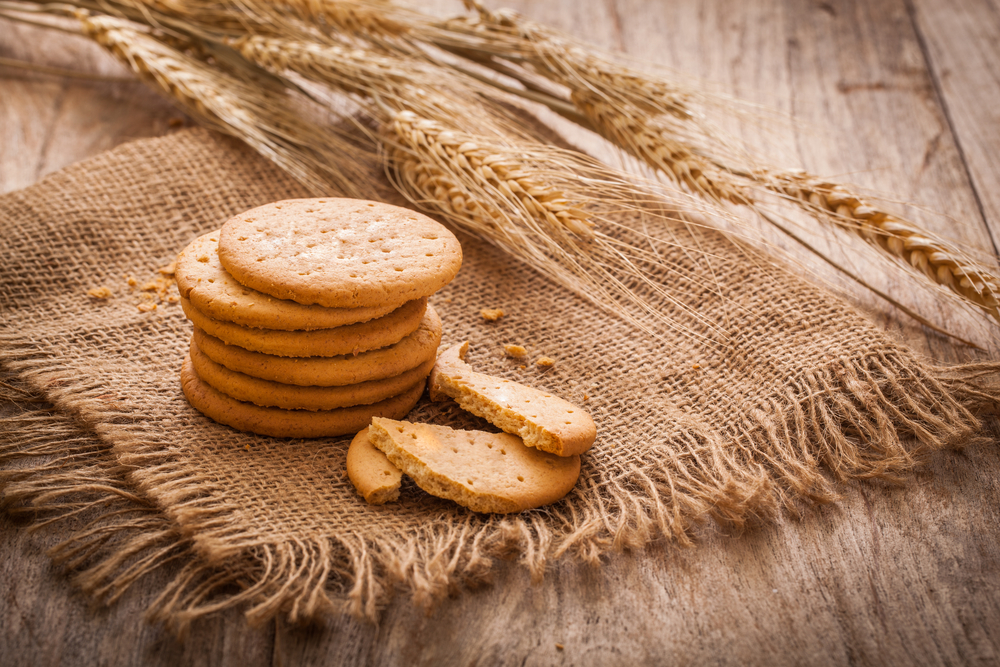I love sausage gravy. It’s a delicious comfort food that reminds me of family breakfasts and dinners. However, sometimes I end up with leftovers that I don’t want to waste.
That’s why I learned how to reheat sausage gravy properly. In this article, I’ll share my tips and techniques for reheating sausage gravy so that it maintains its quality and safety.

Before we dive into reheating techniques, let’s talk about what sausage gravy is and how it’s made. Sausage gravy is a creamy, meaty sauce made with sausage, flour, milk, and seasonings.
It’s typically served over biscuits for breakfast or as a side dish for dinner. To make sausage gravy, you cook crumbled sausage in a skillet, whisk in flour to create a roux, and then gradually add milk to create a creamy sauce.
Once you have leftover sausage gravy, you can store it in an airtight container in the refrigerator for up to four days or in the freezer for up to three months.
Key Takeaways
- Properly reheating sausage gravy can help reduce food waste while maintaining its quality and safety.
- Sausage gravy is a creamy, meaty sauce made with sausage, flour, milk, and seasonings that is typically served over biscuits for breakfast or as a side dish for dinner.
- To reheat sausage gravy, you can use a variety of techniques such as the stovetop, microwave, or oven, but it’s important to keep an eye on the temperature and stir frequently to prevent burning or curdling.
Understanding Sausage Gravy
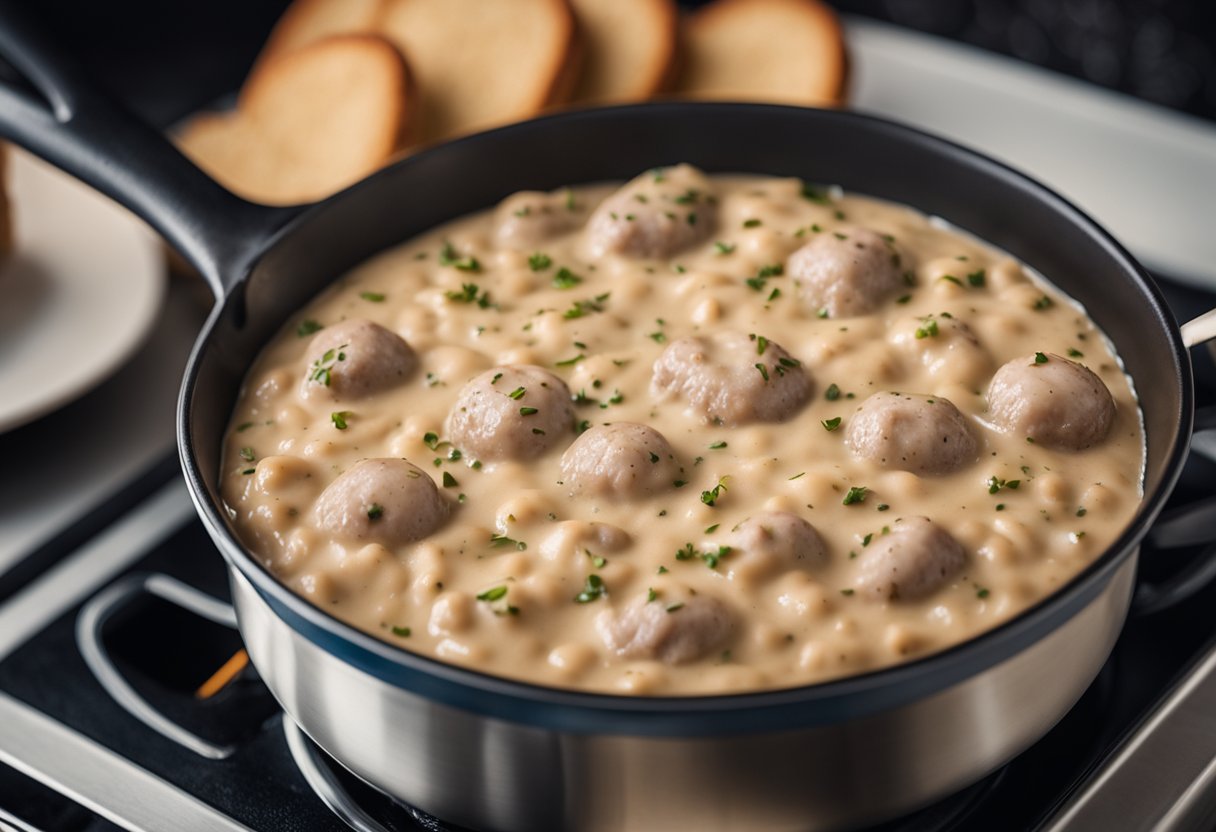
As someone who enjoys cooking and eating, I can tell you that sausage gravy is a delicious and hearty dish that is perfect for breakfast or brunch. It is a creamy and savory sauce that is typically served over biscuits, but it can also be enjoyed with toast, potatoes, or other breakfast foods.
Components of Sausage Gravy
Sausage gravy is made up of a few key components, including sausage, milk, flour, butter, and seasonings. The sausage is usually ground pork that has been seasoned with black pepper, sage, and salt.
The milk is used to create the creamy base for the gravy, while the flour is used as a thickening agent. Butter is added for richness and flavor, and the seasonings are used to enhance the overall taste of the dish.
The Role of Ingredients
The sausage is the star of the show in sausage gravy, providing the dish with its signature flavor. The black pepper, sage, and salt in the sausage help to season the gravy and give it a savory taste.
The milk is used to create the creamy base for the gravy, and it also helps to balance out the saltiness of the sausage. The flour is used as a thickening agent to give the gravy its thick and creamy texture. Butter is added for richness and flavor, and it also helps to thicken the gravy.
Finally, the seasonings, including black pepper, sage, and salt, are used to enhance the overall taste of the dish.
Overall, understanding the components and role of ingredients in sausage gravy is important for creating a delicious and satisfying dish.
With the right combination of sausage, milk, flour, butter, and seasonings, you can create a savory and creamy sauce that is perfect for breakfast or brunch.
Preparation Before Reheating
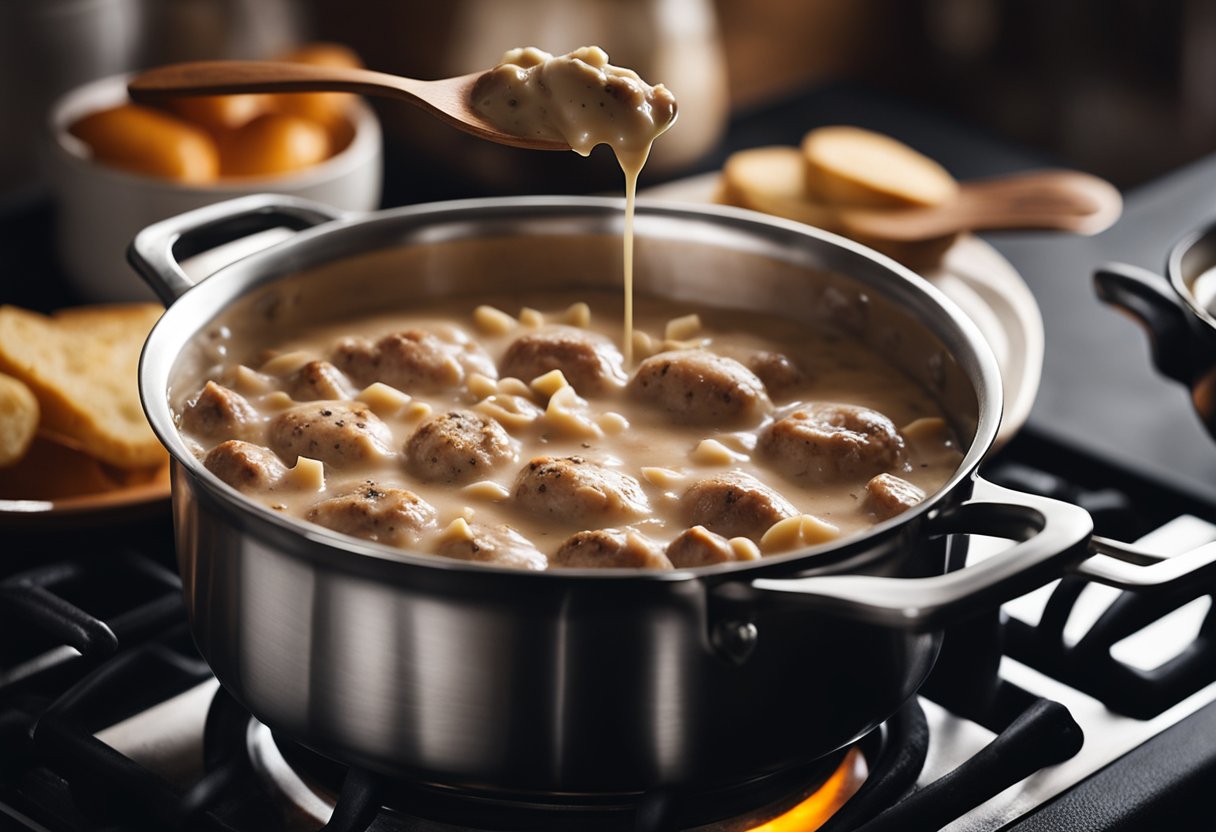
Before reheating sausage gravy, it is essential to prepare it properly. In this section, I will provide you with some tips on how to store your leftover gravy and how to thaw frozen gravy.
Storage Tips
Proper storage is crucial to ensure that your leftover sausage gravy does not go bad. You should store your gravy in an airtight container in the refrigerator. The gravy can last for up to 4 days in the refrigerator.
It is important to note that reheating gravy multiple times increases the risk of bacterial growth. Therefore, it is best to reheat only the amount you need and store the remaining gravy for later use.
Thawing Frozen Gravy
If you have frozen sausage gravy, you should thaw it before reheating. The best way to thaw the frozen gravy is to transfer it to the refrigerator and let it thaw overnight.
Alternatively, you can thaw the gravy in the microwave using the defrost setting. However, this method can result in uneven thawing and may affect the consistency of the gravy.
Once the gravy is thawed, you can reheat it using the methods outlined in the next section.
By following these preparation tips, you can ensure that your sausage gravy is safe to consume and maintains its consistency when reheated.
Reheating Techniques
When it comes to reheating sausage gravy, there are a few methods you can use depending on your preference and the equipment you have available.
Here are three methods that I have found to be effective:
Microwave Method
The quickest and easiest way to reheat sausage gravy is by using a microwave. To do this, transfer your leftover sausage gravy into a microwave-safe bowl or container.
Cover the bowl/container loosely with a microwave-safe lid or plastic wrap. Microwave the gravy on high for 30 seconds, then remove it from the microwave and stir it well.
Repeat this process until the gravy is heated through and reaches the desired temperature. Be sure to stir the gravy well after each interval to ensure even heating.
Stovetop Method
Another way to reheat sausage gravy is on the stovetop. This method is great for those who prefer a more hands-on approach to cooking. To reheat sausage gravy on the stovetop, transfer the gravy into a skillet or saucepan.
Heat the gravy over low heat, stirring constantly to prevent lumps from forming. If the gravy is too thick, you can add a little bit of milk or water to thin it out. Keep whisking the gravy until it reaches the desired consistency.
Oven Method
If you have a larger quantity of sausage gravy to reheat, or if you want to keep the gravy warm for an extended period, reheating it in the oven may be the best option.
To do this, preheat your oven to 350°F (175°C) and transfer the gravy into an oven-safe dish. Cover the dish with foil and heat it in the oven for 10-15 minutes, or until the gravy is heated through.
Be sure to check the gravy periodically to prevent it from drying out or burning.
No matter which method you choose, be sure to reheat the sausage gravy to a temperature of at least 165°F (74°C) throughout.
This will help ensure that any bacteria that may have grown in the gravy are killed off. Also, keep in mind that reheating sausage gravy multiple times increases the risk of bacterial growth. Therefore, it is best to consume reheated gravy within five days if stored in the refrigerator.
Serving and Pairing Ideas

When it comes to serving and pairing sausage gravy, there are a variety of options to choose from.
Here are some classic and creative ideas to consider.
Classic Combinations
Sausage gravy is a classic Southern dish that is often served over biscuits. The combination of the creamy gravy and the flaky biscuit is a match made in heaven. If you want to keep it simple, this is the way to go.
Another classic combination is serving sausage gravy over toast. This is a great option if you don’t have biscuits on hand or if you want a lighter meal. The toast provides a nice crunch and a neutral base for the gravy.
If you’re looking for something heartier, consider serving sausage gravy over mashed potatoes. This is a filling and comforting meal that is perfect for a cold winter day.
Creative Serving Suggestions
If you want to get creative with your sausage gravy, there are plenty of options to consider. One idea is to serve it over pasta. The creamy gravy pairs well with the starchy pasta and creates a delicious and unexpected meal.
Another option is to serve sausage gravy over rice. This is a great way to add some variety to your meal and create a dish that is both filling and flavorful.
If you’re looking for a breakfast option, consider serving sausage gravy over a baked potato. This may seem like an unusual combination, but the creamy gravy pairs well with the fluffy potato and creates a delicious and satisfying meal.
Finally, if you want to take your sausage gravy to the next level, consider using it as a topping for a breakfast casserole. The gravy adds a rich and savory flavor to the casserole and makes for a delicious and filling meal.
Overall, there are plenty of ways to serve and pair sausage gravy. Whether you stick to the classics or get creative with your combinations, you’re sure to end up with a delicious and satisfying meal.
Maintaining Quality and Safety
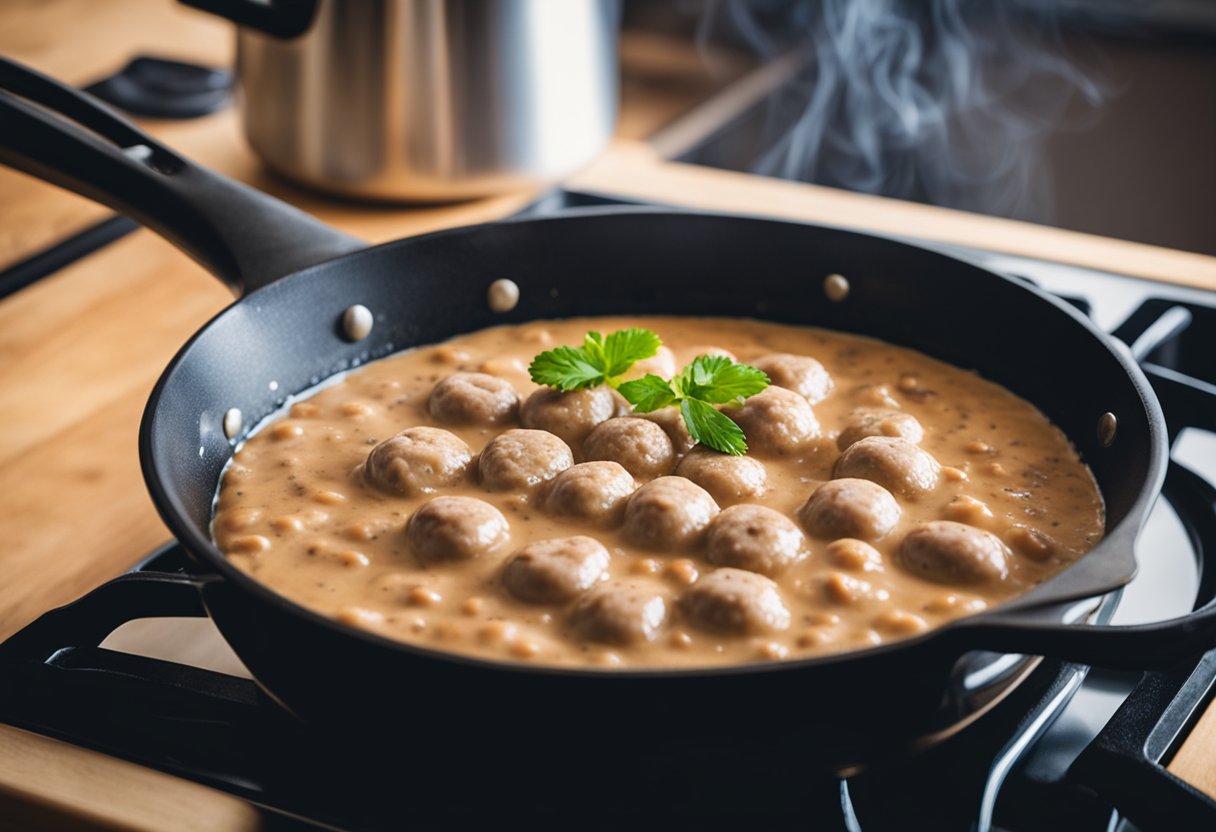
When reheating leftover sausage gravy, it is important to follow certain guidelines to maintain quality and safety.
Here are some tips to help you reheat your sausage gravy properly.
Temperature and Time
To avoid bacterial growth, it is important to reheat sausage gravy to a temperature of at least 165°F (74°C) throughout. This temperature kills any bacteria that may have grown while the gravy was stored in the refrigerator.
When reheating sausage gravy, it is important to do it quickly. Leaving the gravy at room temperature for too long can cause bacteria to grow rapidly.
Therefore, it is recommended to reheat the gravy in small batches. This will help to ensure that the gravy is heated evenly and thoroughly.
Avoiding Common Mistakes
When reheating sausage gravy, it is important to avoid common mistakes that can affect its quality and safety.
Here are some mistakes to avoid:
- Scorching: Overheating sausage gravy can cause it to scorch and stick to the bottom of the pan. To avoid this, it is important to heat the gravy over low heat and stir it frequently.
- Hot Spots: When reheating sausage gravy in the microwave, it is important to stir it frequently to avoid hot spots. Hot spots can cause the gravy to overheat in certain areas, which can affect its taste and texture.
- Leftover Sausage Gravy: Leftover sausage gravy should be stored in an airtight container in the refrigerator for up to five days. After that, it should be discarded. It is not recommended to freeze sausage gravy, as it can affect its texture and taste.
By following these guidelines, you can maintain the quality and safety of your sausage gravy while reheating it.
Frequently Asked Questions
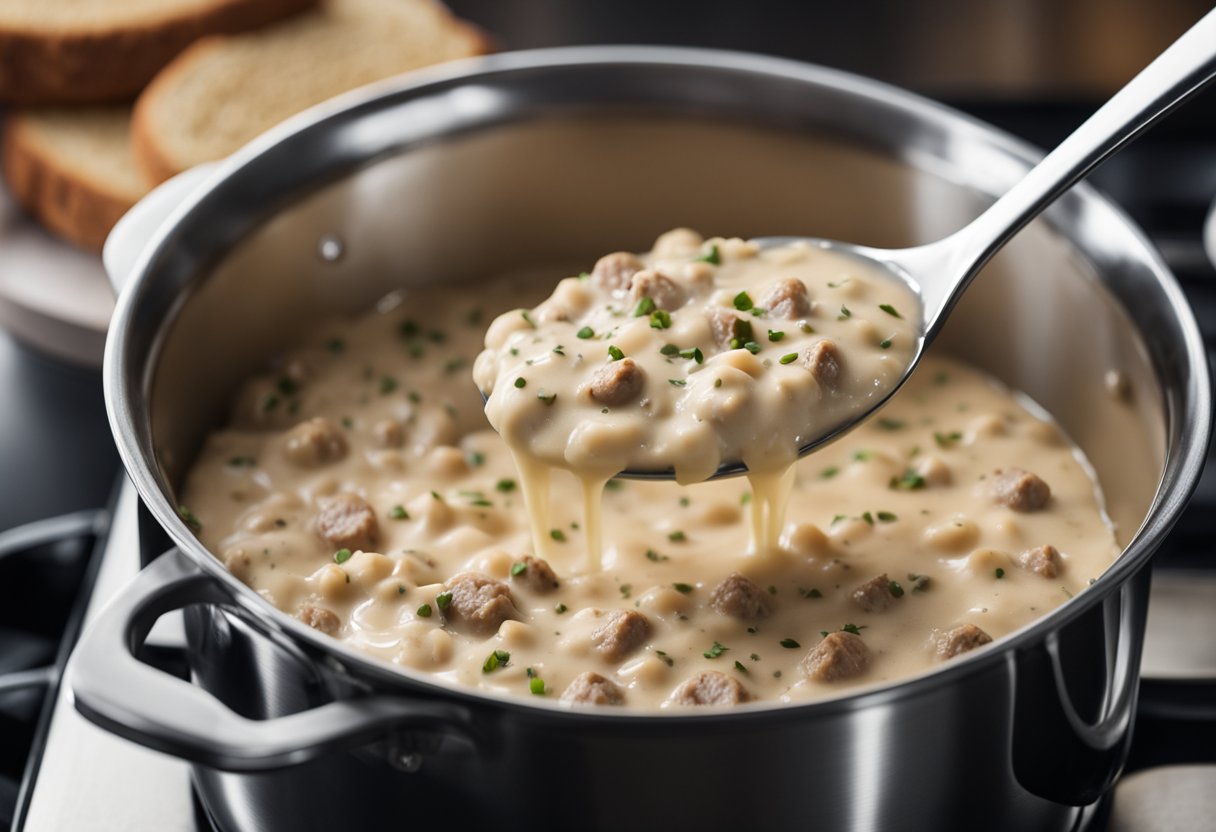
What is the best method to reheat sausage gravy while maintaining its texture and flavor?
The best method to reheat sausage gravy is on the stovetop. This method allows for even heating and helps retain the flavor and texture of the gravy.
To reheat, place the gravy in a saucepan over low heat and stir occasionally until it reaches the desired temperature. Avoid overheating the gravy, as this can cause it to become too thick or congealed.
Is it safe to reheat sausage gravy multiple times, and if so, how many times?
It is safe to reheat sausage gravy multiple times, but it is recommended to reheat it only once. Reheating the gravy multiple times increases the risk of bacterial growth, which can cause foodborne illness.
To ensure safety, reheat the sausage gravy to a temperature of at least 165°F (74°C) throughout.
How long can sausage gravy be stored in the refrigerator before it is no longer safe to consume?
Sausage gravy can be stored in the refrigerator for up to three to four days before it is no longer safe to consume.
To store leftover sausage gravy, transfer it to an airtight container and place it in the refrigerator as soon as possible after it has cooled.
What are the steps for reheating biscuits and sausage gravy together in the oven?
To reheat biscuits and sausage gravy together in the oven, preheat the oven to 350°F (177°C). Place the biscuits on a baking sheet and brush them with melted butter.
Then, place the baking sheet in the oven and bake for 5-7 minutes, or until the biscuits are heated through and lightly browned. Meanwhile, reheat the sausage gravy on the stovetop. Once the biscuits are done, split them open and ladle the hot sausage gravy over them.
What is the proper way to reheat biscuits in the microwave without them becoming too tough?
To reheat biscuits in the microwave without them becoming too tough, wrap them in a damp paper towel and microwave on high for 20-30 seconds. Check the biscuits and repeat in 10-second increments until they are heated through.
Are there any special considerations for reheating homemade sausage gravy as opposed to store-bought?
When reheating homemade sausage gravy, it is important to ensure that it is heated to a temperature of at least 165°F (74°C) throughout to kill any bacteria that may be present.
Store-bought sausage gravy may have preservatives that allow it to be stored for longer periods, but it should still be reheated to a safe temperature before consuming.







